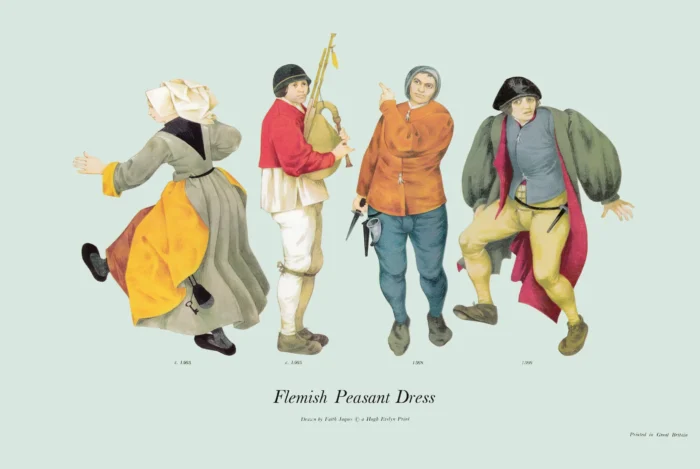Flemish Peasant Dress, 1565-1568
Original price was: £15.00.£10.00Current price is: £10.00.
Flemish Peasant Dress, 1565-1568 (scroll down for a more detailed Description)
Published 1968 by © Hugh Evelyn Limited; drawn by Faith Jaques
Size: c. 38 x 25.5 cm [15″ x 10″] may vary slightly from printers’ cut 50 years ago
Printed on medium cardstock weighing 151 g/sm2 faced in light greyish cyan – lime green (RGB: c. d8e8e0)
Print is STANDARD size – shipping is the same for 1 to 10 prints (based on largest print size in your order) – see Shipping & Returns.
In stock
Description
Spanish domination of the Netherlands was an attempt to retain these dominions faithful to Rome. Wise rule of other Hapsburgs ensured the Flemish part remained Catholic and became what we now know as Belgium. When Peter Brueghel was painting in Antwerp there are already hints of the hated Spanish oppression. The group of armour-clad soldiers in the ‘Massacre of the Innocents’ was a familiar village sight, while the small number of guests at the ‘Village Wedding’ was due to the Spanish decree against more than twenty people meeting together in one house. Antwerp was the richest port in Northern Europe. The Spanish demanded so much profit from the trade that merchants moved to nearby countries, killing the trade of Antwerp in favour of Amsterdam. The peasants in Brueghel’s time look like their parents or grandparents and less modern than the English. The Flemish peasant had deliberately ignored every detail of fashion. The result is a strangely timeless costume that slipped from one period to another, on into the next century and, paradoxically, later served as the basis for high fashion. The beauty of the colours is thanks to the Low Countries being the centre of the dye industry until the 17th century. The Netherland peasants wore clothes for protection, not decoration, and had come to terms with comfort. In a cooler climate layers of clothes were worn regardless of the state of the undergarments. Women’s clothes changed little over 40 years. Bodices were cut separately but still had wide neck openings now worn over a high-necked bodice. Sleeves could be attached at a low, straight shoulderline or tied to the armhole by laces, allowing the chemise to puff through. Neither doublet, jerkin nor bodice show any signs of the exaggerated shoulder width, standing out over the top of the sleeve in epaulets, ‘wings’ or ‘piccadils’, in the most significant detail of high fashion. Women still wore white, stiff kerchief hoods, folded and pinned into a bonnet shape over the head with the ends turned up into intricate and individual folds. These modest head-dresses are only one step removed from those of the women painted by Memling in 1490 and served as a good, decent veil for nuns. The skirt was turned back to protect the front from daily soiling but tucking up the dress over a contrasting petticoat became a popular fashion in the Netherlands. Men wore the long hose of the previous century made in material and shaped by a seam down the back of the legs. The inevitable bagginess was sometimes held in by garters under the knees and the effect of breeches was also made by wearing long socks over the hose, rolled over or under the knee. The codpiece on these garments was a matter of expediency. It is merely a triangular flap laced up to the main garment with no attempt at emphasizing the shape by decoration. The hats were pudding-basin that were a modification of the flat felt bonnet but the brims were no longer cut. In the doublets there is a hint of comfortable fashions to come, like jackets and were with no exaggeration of padding or unnatural shape. The Flemish peasant may have been years behind the times in fashion trends but in one item he appears to have been well ahead. In a portrait by Brueghel a humble old man has real hooks and eyes to fasten his jerkin.
Additional information
| Weight | 0.0147 kg |
|---|---|
| Dimensions | 38 × 25.5 cm |





